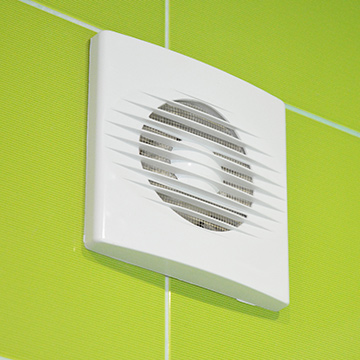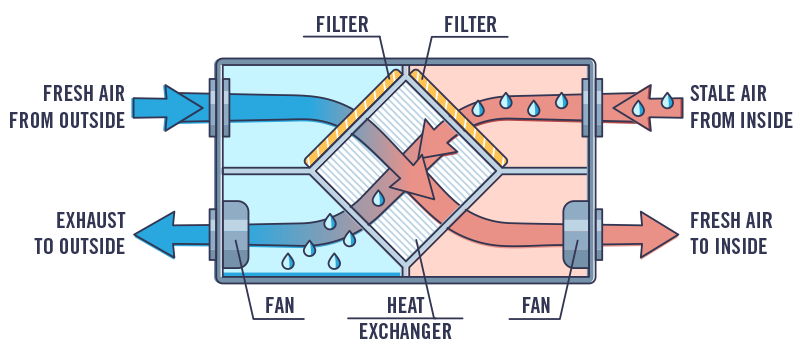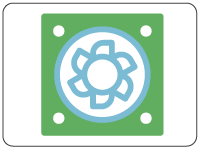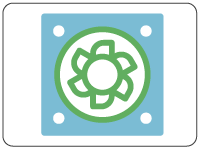Ventilation
Bathroom Fans
Bathrooms fans exhaust moist stale air from a home. This, in turn, encourages fresh outdoor air to enter through the natural leakage paths in your home. This process benefits the resident by:
- Improving indoor air quality for health benefits such as reduced incidence of allergies and asthma
- Reducing the chance of moisture damage to the structure of the home
- Reducing the chances of mold and mildew growth
- Diluting and exhausting carbon dioxide build up from occupant respiration and other indoor pollutants

It is especially important to add ventilation, such as a bathroom fan, to a home that has been weatherized as a tight building envelope allows for little natural air leakage in or out of a home.
Bathroom Fans Require Controllers
The time that someone is occupying the bathroom does not always provide sufficient run time for the fan to eliminate bathroom humidity or contaminants. You will need to install a smart controller that uses a timer to provide adequate time for the fan to run after you leave the bathroom. A controller must be installed to qualify for a BED rebate.
Product Options
The following are just a few of many options for controllers for your bathroom fan. Countdown timers do not qualify.
- Energy Star qualified fan + AirCycle SmartExhaust
The SmartExhaust is a wall switch that replaces your current wall switch. It features a built-in timer that ensures your fan runs for a minimum amount of time everyday. - Panasonic WhisperGreen Select + any of Panasonic Plug ‘N Play modules (FV-VS15VK1, FV-MSVK1 or FV-CSVK1)
The WhisperGreen fan allows the use of specialized modules that add timer, occupancy detection, and humidity detection functionality to your fan.
Installation Tips
- Fan should be sized based on the number of bedrooms in the home.
- One bedroom=50CFM
- Two bedrooms=75CFM
- Three bedrooms=100CFM)
- Use the free Residential Energy Dynamics calculator for more accurate sizing.
- The timer control should be programmed to operate the fan 6 hours per day. This can be 15 minutes out of every hour of the day, or the fan control can be programmed to operate the fan for longer intervals when the home is more likely to be occupied (e.g., between 4:00 PM through 8:00 AM).
- Wherever possible, exhaust ductwork should be smooth wall pipe, sloped to its termination at the outside of the building.
Whole Home Ventilation

- Provides fresh air where it is needed, to the home’s occupied spaces, especially bedrooms.
- Spot ventilation provided by bath fans, kitchen range hoods may still be necessary to remove moisture from the home.
While bathroom fans do an excellent job to rid the home of excess moisture, a whole home ventilation system also provides fresh air where it is needed. This is accomplished through ductwork connected to a heat recovery ventilation unit which brings in fresh air from outside the home. The system supplies fresh air to bedrooms and living rooms while exhausting stale air outside. Further, energy that would be wasted by exhausting conditioned air from the home is recovered and transferred to the supply air by the heat recovery unit.
Heat Recovery Ventilator (HRV) and Energy Recovery Ventilator (ERV)
There are two types of whole home ventilation: HRV and ERV. The main difference is that an HRV transfers sensible heat (i.e. temperature) from one airstream to another, while ERVs transfer both sensible heat and latent heat (i.e. temperature plus the energy trapped in the air’s moisture). There is no universally accepted solution for homes in Vermont. Some units (i.e. Zehnder) have the capability to swap an HRV and ERV core if you later decide that you’d like the other type of system.
Still Have Questions?
Contact BED Energy Services to get started with free, unbiased advice. We’ll walk you through the decision-making process and help you maximize your energy investments.

 Bathroom Fan and Controller
Bathroom Fan and Controller Heat Recovery Ventilation (HRV) & Energy Recovery Ventilation (ERV)
Heat Recovery Ventilation (HRV) & Energy Recovery Ventilation (ERV)